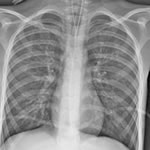Summary
Definition
History and exam
Key diagnostic factors
- wheezing
- shortness of breath
- acute flaccid limb weakness
Other diagnostic factors
- rhinorrhea
- cough
- sneezing
- muscle aches
- fever
Risk factors
- <18 years of age
- history of asthma, wheezing
- history of chronic lung disease
- late summer or fall
Diagnostic tests
1st tests to order
- clinical diagnosis
Tests to consider
- respiratory viral testing
- real-time reverse transcription (rRT) PCR assay or molecular sequencing
- pulse oximetry
- contrast MRI of the spine and brain
- lumbar puncture
- electromyography
- testing for poliovirus
Treatment algorithm
with mild upper respiratory symptoms
with asthma exacerbation or severe unexplained lower respiratory illness
with acute flaccid myelitis
Contributors
Authors
Giovanni Piedimonte, MD, FAAP, FCCP

Vice-President for Research and Institutional Official
Office of Research; Departments of Pediatrics, Biochemistry & Molecular Biology
Tulane University
New Orleans
LA
Disclosures
GP declares that he has no competing interests.
Elisabeth Toverud Landaas, MD, PhD
Senior Medical Officer and Associate Professor in Medical Microbiology
Department of Microbiology
Oslo University Hospital and University of Oslo
Oslo
Norway
გაფრთხილება:
ETL declares that she has no competing interests.
მადლიერება
Dr Giovanni Piedimonte and Dr Elisabeth T. Landaas would like to gratefully acknowledge Dr Charles B. Foster and Dr Neil R. Friedman, both previous co-contributors of this topic. CBF and NRF declare that they have no competing interests.
რეცენზენტები
Megan Culler Freeman, MD, PhD
Assistant Professor of Pediatrics
Division of Pediatric Infectious Diseases
UPMC Children’s Hospital of Pittsburgh
Pittsburgh
PA
გაფრთხილება:
MCF declares that she has no competing interests.
რეცენზენტების განცხადებები
BMJ Best Practice-ის თემების განახლება სხვადასხვა პერიოდულობით ხდება მტკიცებულებებისა და რეკომენდაციების განვითარების შესაბამისად. ქვემოთ ჩამოთვლილმა რეცენზენტებმა თემის არსებობის მანძილზე კონტენტს ერთხელ მაინც გადახედეს.
გაფრთხილება
რეცენზენტების აფილიაციები და გაფრთხილებები მოცემულია გადახედვის მომენტისთვის.
წყაროები
ძირითადი სტატიები
Oermann CM, Schuster JE, Conners GP, et al. Enterovirus D68: a focused review and clinical highlights from the 2014 United States outbreak. Ann Am Thorac Soc. 2015 May;12(5):775-81. აბსტრაქტი
Midgley CM, Jackson MA, Selvarangan R, et al. Severe respiratory illness associated with enterovirus d68 - missouri and illinois, 2014. MMWR Morb Mortal Wkly Rep. 2014 Sep 12;63(36):798-9.სრული ტექსტი აბსტრაქტი
Greninger AL, Naccache SN, Messacar K, et al. A novel outbreak enterovirus D68 strain associated with acute flaccid myelitis cases in the USA (2012-14): a retrospective cohort study. Lancet Infect Dis. 2015 Jun;15(6):671-82. აბსტრაქტი
Centers for Disease Control and Prevention. Non-polio enterovirus: clinical overview of enterovirus D68. Apr 2024 [internet publication].სრული ტექსტი
Centers for Disease Control and Prevention. Acute flaccid myelitis (AFM): clinical guidance for the acute medical treatment of AFM. Jun 2024 [internet publication].სრული ტექსტი
გამოყენებული სტატიები
ამ თემაში მოხსენიებული წყაროების სრული სია ხელმისაწვდომია მომხმარებლებისთვის, რომლებსაც აქვთ წვდომა BMJ Best Practice-ის ყველა ნაწილზე.

დიფერენციული დიაგნოზები
- Rhinovirus infection
- Seasonal influenza infection
- Respiratory syncytial virus infection
მეტი დიფერენციული დიაგნოზებიგაიდლაინები
- Clinical overview of Enterovirus D68
- Acute flaccid myelitis (AFM): clinical guidance for the acute medical treatment of AFM
მეტი გაიდლაინებიშედით სისტემაში ან გამოიწერეთ BMJ Best Practice
ამ მასალის გამოყენება ექვემდებარება ჩვენს განცხადებას